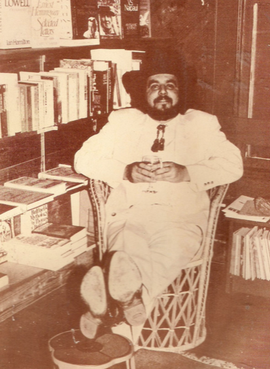
Crystal City is a city in and the county seat of Zavala County, Texas, United States. The population was 6,354 as of the 2020 census. It was settled as a farming and ranching community and was a major railroad stop being 110 miles (180 km) from San Antonio. Spinach became a major crop and the city has promoted itself as "Spinach Capital of the World." During World War II, a large internment camp was located here. The town is also noteworthy in the history of Mexican American political self-determination for the founding of the La Raza Unida Party.

Sidney Clopton Lanier was an American musician, poet and author. He served in the Confederate States Army as a private, worked on a blockade-running ship for which he was imprisoned, taught, worked at a hotel where he gave musical performances, was a church organist, and worked as a lawyer. As a poet he sometimes used dialects. Many of his poems are written in heightened, but often archaic, American English. He became a flautist and sold poems to publications. He eventually became a professor of literature at Johns Hopkins University in Baltimore, and is known for his adaptation of musical meter to poetry. Many schools, other structures and two lakes are named for him, and he became hailed in the South as the "poet of the Confederacy". A 1972 US postage stamp honored him as an "American poet".

Lee College is a public community college in Baytown, Texas. Lee College's main campus occupies 40 acres (160,000 m2) near downtown Baytown and extension campuses throughout its service area. The school has an enrollment of over 7,773 total students as of Fall 2018. Approximately 83% are part-time students, and about 17% are enrolled full-time. The college offers over 60 academic, technical education, and non-credit continuing education programs.

Alamo Stadium is a horseshoe-shaped football and soccer stadium in the Monte Vista Historic District of San Antonio, Texas. Nicknamed "The Rock Pile" due to its primarily limestone construction it was completed in September 1940 as a Works Progress Administration project. The stadium is currently owned and operated by the San Antonio Independent School District as a high school football and soccer facility. It has a seating capacity of 18,500, making it the 3rd largest high school stadium in the state of Texas.
San Antonio Independent School District is a school district based in San Antonio, Texas, United States.

Carmen Martín Gaite was a Spanish author who wrote many novels, short stories, screenplays, and essays across multiple genres. Her work has received significant recognition: in 1957, she was awarded the Premio Nadal for Entre visillos; in 1988 she won the Prince of Asturias Award;in 1992 she received the Premio Castilla y León de las Letras, and she also was awarded the Premio Acebo de Honor for her life's work.

The LVI Legislature of the Congress of the Union of Mexico met from 1994 to 1997.
Rafael C. Castillo is an American writer, who was the first editor of ViAztlan: an international journal of Arts and Letters established in San Antonio, Texas, in 1979. The journal was funded through the City of San Antonio and the culture-based arts organization Centro Cultural de Aztlan. A veteran freelance writer, Castillo authored articles germane to the Mexican-American community and established philosophy-based issues and supported international causes that promoted Mexican American arts and letters. He later served as contributing editor of The Saguaro,a literary journal published at the University of Arizona, Tucson. In 1985, Castillo visited Paris, France, and met briefly with David Appelfield, editor of FRANK, an international literary journal, and became its San Antonio correspondent. In 2001, Castillo was asked to serve on the editorial board of Puentes, an international bilingual journal based at Texas A&M University–Corpus Christi.
South Texas Independent School District (STISD) is a magnet school district headquartered in Mercedes, Texas (USA). STISD operates magnet schools that draw students from three counties: Cameron, Hidalgo and Willacy. STISD covers an area of 3,643 square miles (9,440 km2), overlapping 28 other school districts.
San Marcos Consolidated Independent School District is a public school district based in San Marcos, Texas, USA. The school district covers 210 square miles mainly in Hays County and portions of Guadalupe and Caldwell counties.

José Luis Montalvo was a Chicano writer, poet, and community activist.

The Mexican American Youth Organization is a civil rights organization formed in 1967 in San Antonio, Texas, USA to fight for Mexican-American rights. The creators of MAYO, Los Cinco, consisted of José Ángel Gutiérrez, Willie Velásquez, Mario Compean, Ignacio Pérez, and Juan Patlán. MAYO and its political organization, Raza Unida Party, played an important part in Texas history during the late 1960s and early 1970s. They were a part of the larger Chicano movement in the United States, and played a role in bringing about civil rights for Mexican-Americans.
Thomas Jefferson High School is a public high school in San Antonio, Texas and is one of ten high schools in the San Antonio Independent School District. Completed in 1932 at a cost of $1,250,000, it was the third high school built in the city. During 2022–2023, Jefferson High School had an enrollment of 1,686 students and a student to teacher ratio of 14.40. The school received an overall rating of "B" from the Texas Education Agency for the 2021–2022 school year.
Estacado Early College High School is a 4A public high school serving grades 9 through 12 in Lubbock, Texas, (USA). It is part of the Lubbock Independent School District. Estacado is a magnet school, with programs in JROTC. As of August 2016, Estacado High School became Estacado Early College High School, due to the partnership with Texas Tech University. Students, starting in the ninth grade, will be able to earn up to 60 hours of college dual credit hours.
The Museo Alameda was the largest Latino museum in the United States and the first formal Smithsonian affiliate outside of Washington D.C., located in the historic Market Square in Downtown San Antonio, Texas.
Events in the year 1968 in Mexico.
Events in the year 1970 in Mexico.
Fox Technical High School is a public high school located in central San Antonio, Texas and classified as a 4A school by the University Interscholastic League. This school is one of twelve schools in the San Antonio Independent School District. During 2022–2023, Fox Tech High School had an enrollment of 499 students and a student to teacher ratio of 17.36. The school received an overall rating of "B" from the Texas Education Agency for the 2021–2022 school year.

Alazán-Apache Courts is a public housing community in San Antonio. The neighborhood is located on the city's West Side, and was built in 1939. It was the first public housing built in the city and is currently made up of three different properties: Alazán, Apache and Guadalupe Homes. It is also one of the first public housing projects in the United States and originally served a predominantly Mexican-American neighborhood.
Joseph "Joe" Bernal is an American politician. He was a significant figure in the Chicano community. Bernal spent eight years in the Texas Legislature. Bernal was in both the Texas House of Representatives and the Texas Senate. Bernal was in the Texas House of Representatives from 1964 to 1966, He was in the Texas Senate from 1966 to 1972. When Bernal got his start in politics 80% of Chicanos were not graduating high school. Now only 30% are not graduating which he says is still a high percentage. During his time in politics, Bernal produced many opportunities for schooling and opportunities for the Chicano community as a whole. The impact that Bernal had on his community got San Antonio school district superintendent Oscar Miller to meet with community sponsors such as Senator Bernal and others to address Chicano/a student's demands for improved school facilities.









